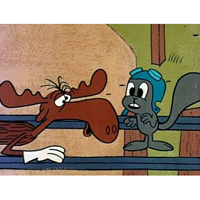
Rocky and Bullwinkle
CBUB Wins: 4
CBUB Losses: 0
CBUB Ties: 0
Win Percentage: 100.00%
Added by: Schornforce
The Rocky and Bullwinkle Show is the collective name for two American television animated cartoon series: Rocky and His Friends (1959–1961) and The Bullwinkle Show (1961–1964). Rocky & Bullwinkle enjoyed popularity during the 1960s. It was targeted towards children and adults. The zany characters and absurd plots would draw in children, while the clever usage of puns and topical references appealed to the adult demographic. Strengths helped it overcome the fact that it had choppy, limited animation; in fact, some critics described the series as a well-written radio program with pictures.
The idea for the series was created by Jay Ward and Alex Anderson, who had previously collaborated on Crusader Rabbit, and was based upon the original property The Frostbite Falls Revue. This original show never got past the proposal stage. It was about a group of forest animals running a TV station. The group included Rocket J. Squirrel, Oski Bear, Canadian Moose (Bullwinkle), Sylvester Fox, Blackstone Crow, and Floral Fauna. The show in this form was created by Jay Ward's partner Alex Anderson. * Bullwinkle's name came from a friend of Jay Ward's, Clarence Bullwinkel, who was a property owner and landlord in Berkeley, California.
Ward wanted to produce the show in Los Angeles; however, Anderson lived in the San Francisco Bay Area and did not want to relocate. As a result, Ward hired Bill Scott, who became the head writer and co-producer at Jay Ward Productions, and who wrote all of the Rocky and Bullwinkle features. Ward was joined by writers Allan Burns (who later became head writer for MTM Enterprises) and Chris Hayward.
The series began with the pilot Rocky the Flying Squirrel. Production began in February 1958 with the hiring of voice actor June Foray, Paul Frees, Bill Scott, and William Conrad. Eight months later, General Mills signed a deal to sponsor the cartoon, under the condition that the show be run in a late-afternoon time slot, where it could be targeted toward children. Subsequently, Ward hired most of the rest of the production staff, including writers and designers. However, no animators were hired, since Ward was able to convince friends of his at Dancer, Fitzgerald, & Sample — an advertising agency that had General Mills as a client — to buy an animation studio in Mexico called Gamma Productions S.A. de C.V. (originally known as Val-Mar Animation). This outsourcing of the animation for the series was considered financially attractive by primary sponsor General Mills, but caused numerous problems. Bill Scott, when interviewed by animation historian Jim Korkis in 1982, described some of the problems that arose in the production of the series:
CBUB Match Record:
| Result | Opponent | My Score | Their Score | |
|---|---|---|---|---|
| Win | Sam & Max | 42 | to | 25 |
| Win | Abbott and Costello | 251 | to | 140 |
| Win | Ren and Stimpy | 19 | to | 11 |
| Win | Sully & Mike | 18 | to | 8 |
No Fantasy Draft Records Available
